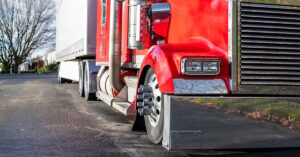Truck manufacturers are rethinking cab design as they look to appeal to the next generation of professional drivers – those who are tech-savvy, diverse and innovative.
This means bringing greater consistency to how and where controls are mounted, and aiming to give drivers a consistent experience whether behind the wheel or in the sleeper cab.

“What do they need in the environment around them? Simplicity. Situational adaptation. Safety. Integration,” rhymed off Johan Agebrand, director of product marketing at Volvo Trucks. He was speaking at a Technology & Maintenance Council session on driver interfaces.
Volvo, and other truck makers, are aiming to better integrate systems into the cab. Communication with the driver is also being enhanced. The dashes in older trucks would light up like a Christmas tree when fault codes were active. Now, specific error messages are displayed to the driver in plain language so they know how critical a potential fault is.
With the vast majority of highway trucks now spec’d with automated manual transmissions, OEMs are also taking advantage of the shifter stalk to give drivers access to more controls – such as the engine brake – without having to reach. The shift away from manual transmissions means less reaching for drivers, and reduced wear and tear on their shoulders. It also frees up valuable real estate between the seats.

Volvo’s new VNL has electronic switch-style parking brakes that are effortless to pull or push, and a pushbutton ignition similar to those found in many cars. Agebrand also said drivers can customize the gauge display in some of today’s digital information displays.
The controls in the sleeper cab should be integrated with those in the front of the truck, and they should be arranged consistently. “The sleeper controls will now, in many cases, be fully integrated. In the sleeper, I do the exact same things as I do in the front to control the radio, cameras, lighting, temperature, battery management and APU,” he said.
A safer environment
Future trucks will come from the factory with more cameras installed, including those that offer visibility of the back of the trailer. They will come with night vision capabilities and in some cases will replace the traditional west coast mirrors.
“In 10 years, I don’t think any of us will imagine driving a truck without this system,” Brianna Potthast, on-highway marketing manager with Kenworth said of camera mirror systems (CMS).
David Brandos, head of North American sales, fleet products and services with Stoneridge, maker of that system, agreed. “Your trucks are going to look different,” he said. “There is going to be major change for your drivers. We’ve done a lot to take advantage of muscle memory. Everything we’ve done is an attempt to emulate what drivers already have in their glass mirrors.”
Cameras are able to offer better visibility of the area around the truck, including the troublesome passenger side blind spot. They are heated and the view doesn’t become obstructed by road spray or snow.
“These systems are quite sophisticated,” Brandos said. “The goal is to enhance visibility.”
They offer the ability to zoom in and out, provide visibility around the truck, and can even produce reference lines to help drivers with backing or judging distances. They also record footage so it can be used in the event of an incident.
In some applications, Brandos said the cameras can provide a tangible fuel economy improvement when the traditional mirrors are removed. U.S. regulations allow fleets to remove the mirrors off trucks equipped with camera mirror systems, but OEMs are not yet permitted to build trucks without mirrors as they are in Europe. Canadian regulators haven’t yet offered a similar exemption to allow traditional mirrors to be replaced by CMS, but suppliers including Stoneridge are lobbying for that to change.
“I think five years from now you will be challenged to buy a truck with glass mirrors,” Brandos added.
As more cameras are added to the vehicle, they will come with greater functionality, Potthast said. They will be able to zoom in and out, pan along the length of the trailer, and eventually even come equipped with AI for object recognition. Drivers will have a view of the rear of the trailer and the loading dock they’re backing into.

Smarter features
As trucks evolve they’ll also come equipped with more “smart features” to help drivers with tasks such as trip inspections. There are already systems available today that will cycle through the lights during the pre-trip, Potthas pointed out. Another welcomed benefit will come in the form of apps that allow remote starting and climate control so drivers can climb into a pre-heated or cooled truck after a break.
Anastasia Makarova, on-highway segment strategy manager with Daimler Truck North America, said a clean dash design can enhance driver safety. When it comes to advanced driver assistance systems (ADAS), manufacturers must continue to improve the human-machine interface, she added.
“How do we start to balance the types of alerts we have within the systems?” she said of one ADAS-related challenge. “There are so many things that can be beeping at you at any one time; how do we ensure the message the driver is receiving is the most important one?”
Instead of displaying a Check Engine light, the driver displays need to communicate precisely what is wrong with the truck and how urgent the situation is, Potthas said.
“Is this critical? Or can I deliver my load and then take care of this?” she said of driver decisions that the truck will help them make.
And the cab environment must also be designed to keep up with evolving driver needs and interests, many of which require more power.
“The amount of stories I hear about truck drivers coming to rest at the end of the day and starting to play the truck simulator game in the back of the cab,” she chuckled. “So, they’re adding gaming consoles and larger TVs in the cab. How do we, as OEMs, make sure there’s enough power for those features? Are the mounting brackets we are providing big enough for what they’re trying to put in there without creating damage to the back of the sleeper area? How does it come together as a holistic experience that’s similar and repetitive for these drivers to make their lives easier on the road, and also keep them safe?”








